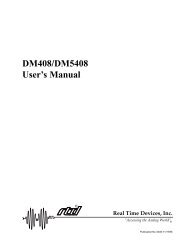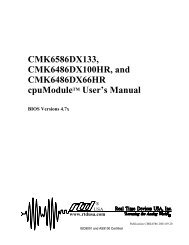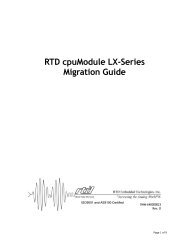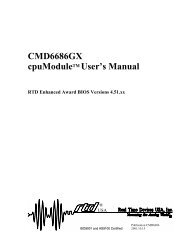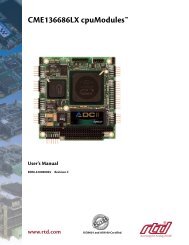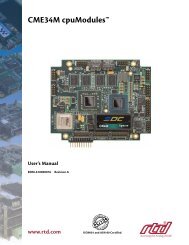RTD/Target Catalog - RTD Embedded Technologies, Inc.
RTD/Target Catalog - RTD Embedded Technologies, Inc.
RTD/Target Catalog - RTD Embedded Technologies, Inc.
You also want an ePaper? Increase the reach of your titles
YUMPU automatically turns print PDFs into web optimized ePapers that Google loves.
“Accessing the Analog World”<br />
Triggering<br />
If it is crucial to get the data you want, when you want it, then it follows<br />
that being able to communicate to your DAQ system which data you want<br />
is equally important. Triggering accomplishes this task. In fact, the more<br />
triggering options a board offers, the better the likelihood you will collect<br />
good data. <strong>RTD</strong> offers an abundance of triggering options that allow you<br />
to define how and when to capture data to ensure that you get the information<br />
you need.<br />
An oscilloscope is a specialized data acquisition system. If you let it run<br />
freely you will see lots of data. However, little information will be gained<br />
from the blur on the screen unless you use triggers. A trigger is an event<br />
happening. Some real world examples are when a pulse starts or ends, a<br />
warning light turns on or off, or an overload is detected.<br />
“Stackable,<br />
powerful,<br />
and optimized for<br />
success...”<br />
To get information from your DAQ you have to trigger it like an oscilloscope.<br />
There are three things that could happen when you get a trigger.<br />
A pre-trigger starts the DAQ, a post-trigger stops the DAQ, or an abouttrigger<br />
collects some data before and after the event. <strong>RTD</strong>’s many internal<br />
and external start, stop, and about trigger options give you all of<br />
these functions.<br />
Features of Start, Stop, and About Triggers<br />
Software<br />
External<br />
Digital Interrupt<br />
Timer/Counter<br />
Gated<br />
Sample Counter<br />
Sync Bus<br />
Trigger under software control<br />
Trigger on an external rising or falling edge<br />
Trigger when digital I/O matches a preset state or when<br />
any digital bit changes<br />
Trigger when a timer/counter expires<br />
Collect data when an external signal is active (signal can<br />
be either active low or active high)<br />
Trigger after a programmed number of samples<br />
have been collected<br />
Trigger multiple boards simultaneously<br />
This PC/104-Plus stack includes<br />
an AMD Geode LX cpuModule,<br />
a DSP Coprocessor, a 16-channel,<br />
12-bit analog module with Autonomous<br />
SmartCal, and an 83 Watt<br />
power supply.<br />
Skip Bit<br />
Skip bits allow sampling different channels at different rates while maintaining<br />
accurate individual channel timing. The diagrams show how to sample channel 1<br />
once every second and channel 4 once every three seconds. To take a set of eight<br />
samples, six from channel 1 and two from channel 4 (shown in the top diagram)<br />
make 12 entries into the channel-gain scan memory (bottom diagram) and set the<br />
pacer clock to run at 0.5 seconds. Four of the entries are skipped (skip bit set) and<br />
no A/D conversion is performed. Samples are not stored when they are not wanted,<br />
saving memory and eliminating the need to throw away unwanted data.<br />
PACER CLOCK<br />
A/D CONVERSION<br />
SAMPLED CHANNEL 1 1 1 4 1 1 1 4<br />
skip<br />
1 4 1 4 1 4 1 4 1 4 1 4<br />
1 sec<br />
skip<br />
1 sec<br />
skip<br />
3 sec<br />
skip<br />
1 sec 1 sec 1 sec 1 sec<br />
<strong>RTD</strong> <strong>Embedded</strong> <strong>Technologies</strong>, <strong>Inc</strong>. | 2010 Product Guide<br />
25



